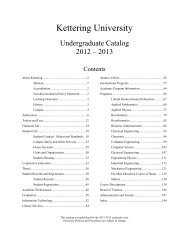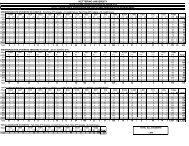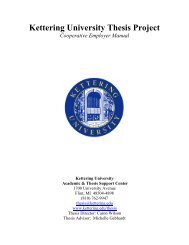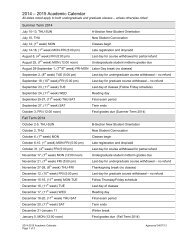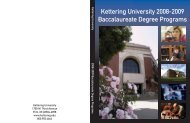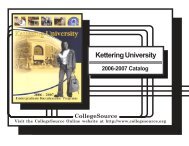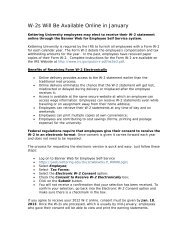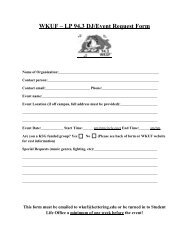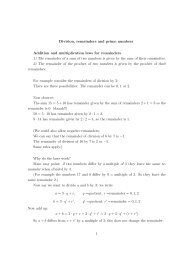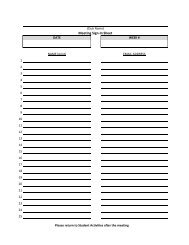Module 4. Refrigeration and Heat Pump Systems The Vapor ...
Module 4. Refrigeration and Heat Pump Systems The Vapor ...
Module 4. Refrigeration and Heat Pump Systems The Vapor ...
You also want an ePaper? Increase the reach of your titles
YUMPU automatically turns print PDFs into web optimized ePapers that Google loves.
Assumptions: SSSF, Negligible ∆KE <strong>and</strong> ∆PE, Single-Inlet, Single-Outlet conditions<br />
K. Nasr,c:\thermo \module<strong>4.</strong>doc<br />
Process Device 1st Law 2nd Law<br />
.<br />
.<br />
1→2: Isentropic Compression Compressor<br />
WComp . = m(h1 − h<br />
2)<br />
s 2 = s 1<br />
.<br />
.<br />
2 →3: p = C. <strong>Heat</strong> Rejection Condenser<br />
QCond.<br />
= m(h3 − h<br />
2)<br />
s 2 > s 3<br />
3 →4: Adiabatic Throttling Throttling Device h 3 = h 4 s 4 > s 3<br />
(O-Tube, TXV)<br />
.<br />
.<br />
4 →1: p = C. <strong>Heat</strong> Absorption Evaporator<br />
Q = m(h − h )<br />
s 1 > s 4<br />
COP = Q Evap . / W Comp .<br />
Evap.<br />
1 4<br />
¯<br />
Actual Cycle Operation: Deviates from ideal cycle operation by having:<br />
1. Pressure drops due to friction in connecting pipes<br />
2. <strong>Heat</strong> transfer exists across connecting pipes<br />
3. Pressure drops occur through the condenser <strong>and</strong> evaporator tubes<br />
<strong>4.</strong> <strong>Heat</strong> transfer occurs from the compressor<br />
5. Frictional effects <strong>and</strong> flow separation occur on the compressor blades<br />
6. Refrigerant vapor entering the compressor may be slightly superheated<br />
7. Refrigerant temperature exiting the condenser may be slightly below saturation.<br />
A desirable effect out of the above list is item 7. Having a subcooled liquid exiting the<br />
condenser results in having a larger refrigeration effect.<br />
Problem:<br />
A vapor-compression refrigeration system for a household refrigerator has a refrigerating capacity of<br />
1000 Btu/h. <strong>The</strong> refrigerant, R134a, enters the evaporator at –10 °F <strong>and</strong> exits at 0 °F. <strong>The</strong> isentropic<br />
compressor efficiency is 80%. <strong>The</strong> refrigerant condenses at 95 °F <strong>and</strong> exits the condenser subcooled<br />
at 90 °F. <strong>The</strong>re are no significant pressure drops in the flows through the evaporator <strong>and</strong> condenser.<br />
We want to determine the evaporator <strong>and</strong> condenser pressures, the mass flow rate of the refrigerant,<br />
the compressor power input, <strong>and</strong> the coefficient of performance.<br />
Solution:<br />
• First, the refrigerating capacity is the rate of heat transfer into the refrigerant flowing in the<br />
evaporator. It is the cooling effect, that is the rate of heat transfer extracted from air on the outside<br />
of the evaporator. <strong>The</strong> refrigerating capacity is normally given in tons of refrigeration for a system<br />
where one ton of refrigeration is equivalent to 12000 Btu/hr.<br />
• Second, since the inlet to the evaporator is always a mixture of liquid <strong>and</strong> vapor, the pressure<br />
therefore is the saturation pressure at the given temperature. It is also assumed that frictional effects,<br />
between the refrigerant <strong>and</strong> the tubes of the evaporator, are neglected so that the pressure at the<br />
inlet equals the pressure at the exit of the evaporator.<br />
Copyright © 2004, K. Nasr. All Rights Reserved Page 3



